She-Oak and sunlight: 'the best feelgood show I have seen since COVID'
- Written by Sasha Grishin, Adjunct Professor of Art History, Australian National University
Review: She-Oak and sunlight: Australian Impressionism, NGV Australia, Federation Square, Melbourne
She-Oak and sunlight is a visually stunning exhibition that brings together some of Australia’s most famous and much-loved paintings and presents them within a radically different context.
Dr Anne Gray, the curator of this exhibition, dismisses the traditional title for these painters, “The Heidelberg School”, as a misnomer — they worked in Eaglemont, not Heidelberg, and it was never a school.
She also argues in her exhibition the idea this was a purely “blokey” orientation in art, with Tom Roberts, Arthur Streeton, Charles Conder and Frederick McCubbin as the only serious members, needs to be revised.
They shared the limelight with a number of talented women artists including Jane Sutherland, Clara Southern, Iso Rae, May Vale, Jane Price and Ina Gregory, all of whom are present in considerable numbers in this exhibition.
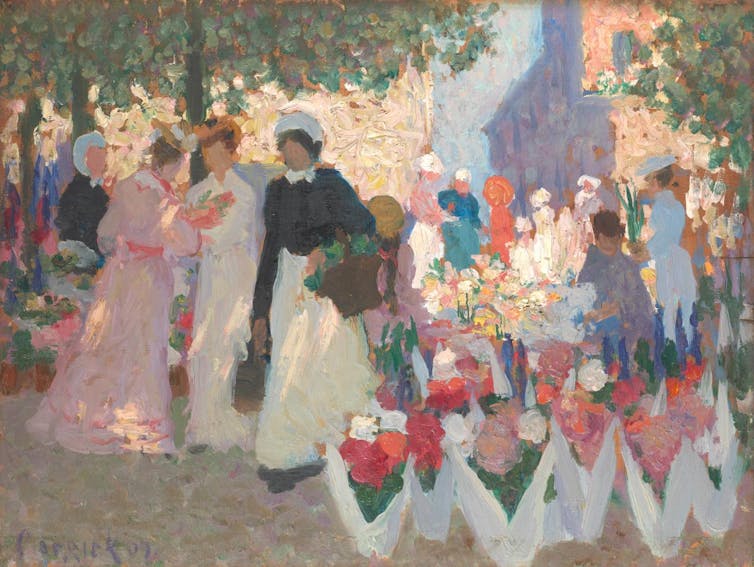 Ethel Carrick, Australia, 1872-1952, Flower market, 1907. Oil on wood panel.
National Gallery of Victoria, Melbourne. Presented through The Art Foundation of Victoria by the late Major B. R. F. MacNay, and Mrs D. Mac`Nay, Fellow 1994
Ethel Carrick, Australia, 1872-1952, Flower market, 1907. Oil on wood panel.
National Gallery of Victoria, Melbourne. Presented through The Art Foundation of Victoria by the late Major B. R. F. MacNay, and Mrs D. Mac`Nay, Fellow 1994
Finally, Gray contextualises the narratives presented by these painters with older co-existing narratives by contemporary Australian Indigenous artists, especially William Barak.
Read more: Explainer: the importance of William Barak’s Ceremony
The title of the show, She-oak and sunlight, is derived from the title of a small painting by Tom Roberts, recently acquired by the NGV, exhibited in one of Australia’s most famous/notorious exhibitions of all time, the 9 by 5 Impression Exhibition that opened August 17, 1889 at Buxton’s Art Gallery, Swanston Street, Melbourne.
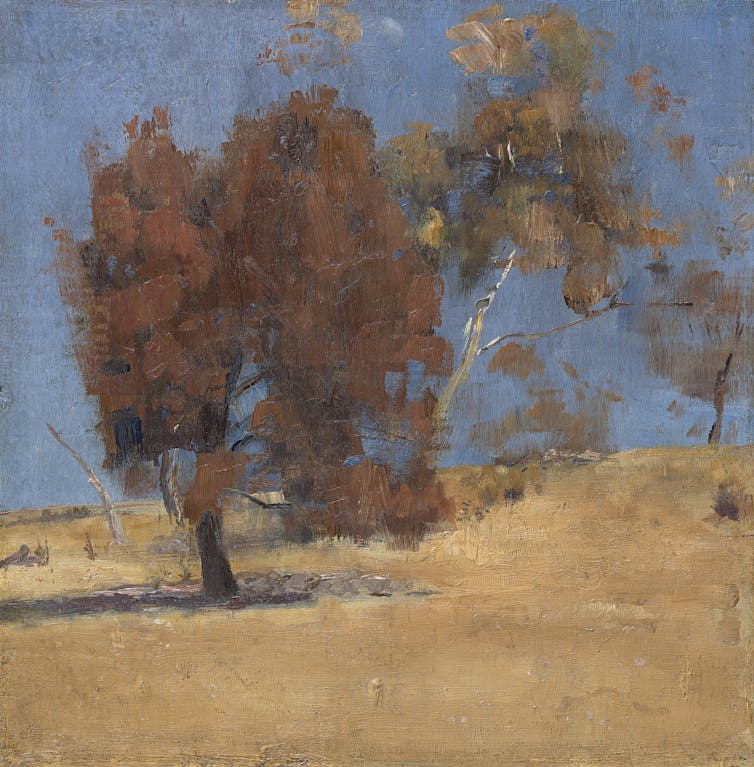 Tom Roberts, Australia 1856–1931, She-oak and sunlight, 1889. Oil on wood panel, 30.4 × 30.1 cm.
National Gallery of Victoria, Melbourne. Jean Margaret Williams Bequest, K. M. Christensen and A. E. Bond Bequest, Eleanor M. Borrow Bequest, The Thomas Rubie Purcell and Olive Esma Purcell Trust and Warren Clark Bequest, 2019
Tom Roberts, Australia 1856–1931, She-oak and sunlight, 1889. Oil on wood panel, 30.4 × 30.1 cm.
National Gallery of Victoria, Melbourne. Jean Margaret Williams Bequest, K. M. Christensen and A. E. Bond Bequest, Eleanor M. Borrow Bequest, The Thomas Rubie Purcell and Olive Esma Purcell Trust and Warren Clark Bequest, 2019
Roberts’s She-oak and sunlight appeared as no. 19 in the catalogue and perfectly epitomises the mood of the exhibition. The she-oak, or Casuarina, is native to Australia. The show celebrates the “Australianness” of the vegetation and topography, and stresses the quality of the intense, bleaching light in this country.
This is the best feelgood show I have seen since COVID, glowing and basking in nationalism and optimism.
The French and the Australians
The extent to which these painters could be described as “impressionists” depends a little bit on definitions.
Like the French Impressionists, these Australian painters worked outside en plein air, they made rapid, sketchy paintings that favoured landscapes and everyday subjects, they employed compositional structures influenced by photography and they were aware — even if in some cases indirectly — of the work of the French artists.
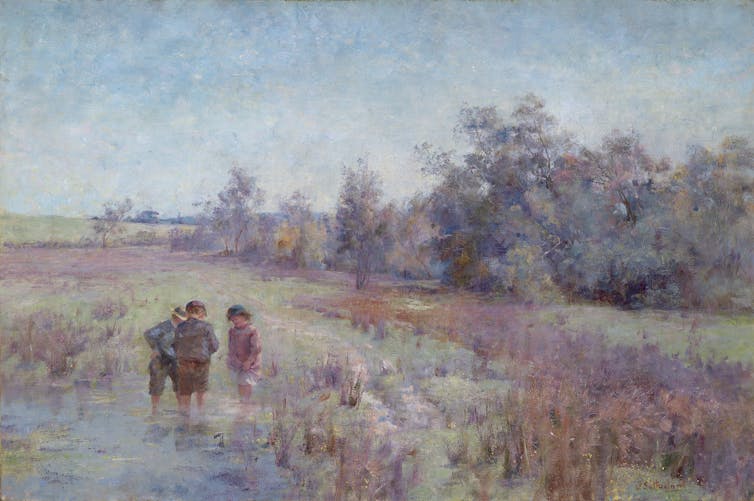 Jane Sutherland, United States, 1853-1928, Field naturalists c.1896. Oil on canvas, 80.9 × 121.3 cm.
National Gallery of Victoria, Melbourne. Gift of Mrs E. H. Shackell,1962
Jane Sutherland, United States, 1853-1928, Field naturalists c.1896. Oil on canvas, 80.9 × 121.3 cm.
National Gallery of Victoria, Melbourne. Gift of Mrs E. H. Shackell,1962
In the 9 by 5 catalogue (the name derived from the fact many of the paintings in the show were painted on nine by five inch cedar cigar box lids), the artists stated:
An effect is only momentary; so an impressionist tries to find his place. Two half hours are never alike […] So in these works, it has been the object of the artist to render faithfully, and thus obtain first records of effects widely differing, and often of very fleeting character.
The French Impressionists’ use of “colour theory”, with paint applied in small adjacent dabs of colour and the whole colour palette moved to the ultraviolet end of the spectrum, was in little evidence in the 1889 Melbourne exhibition. Most of the Australian paintings had colour applied traditionally in tonal gradations.
Some Australian artists who lived primarily in France, especially John Peter Russell, were much closer to the French Impressionists in mood, spirit and technique, but these were essentially expats.
Read more: From Monet to Rodin, John Russell: Australia's French Impressionist maps artistic connections
Outstanding visual intelligence
Prior to this show, the benchmark exhibition of Australian impressionists was Jane Clark’s Golden Summers: Heidelberg and beyond held at the NGV in 1985 that broke all records for attendances. A less successful exhibition covering similar ground was held at the same gallery in 2007.
Gray’s exhibition, with over 250 artworks, is outstanding for its scope, scale and visual intelligence in the way it has been presented. Not only have all of the key works been assembled from around Australia, which is no mean feat — for example, to prise out of the Art Gallery of Western Australia, McCubbin’s Down on his luck, 1889, a destination painting — but new visual connections are created throughout the show.
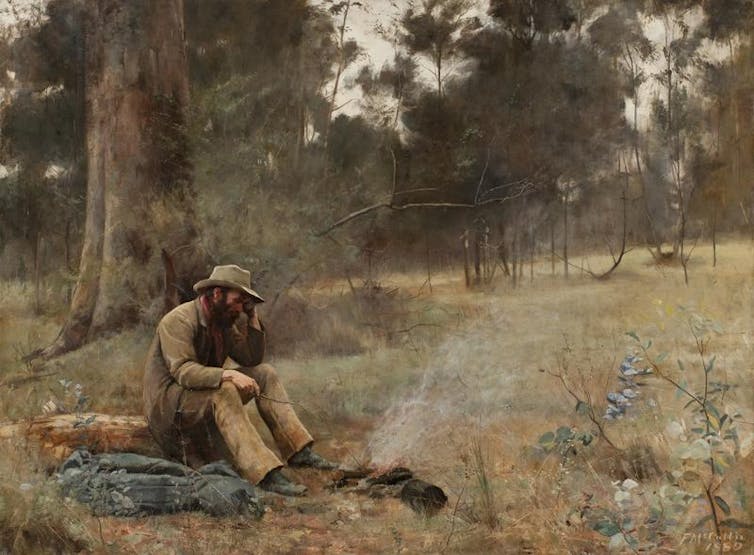 Frederick McCubbin, Australia, 1855-1917, Down on his luck c.1889. Oil on canvas.
Purchased 1896, State Art Collection, Art Gallery of Western Australia
Frederick McCubbin, Australia, 1855-1917, Down on his luck c.1889. Oil on canvas.
Purchased 1896, State Art Collection, Art Gallery of Western Australia
A painting by the French Impressionist, Alfred Sisley in the collection of the NGV is juxtaposed with Russell’s painting of Madame Sisley in the collection of the Art Gallery of NSW. Gray has realised both were painted on the same spot in Moret-sur-Loing with the same white chalk cliff in the background.
Édouard Manet, Claude Monet and James Abbott McNeill Whistler all feature in this exhibition to demonstrate the international artistic milieu in which these artists operated.
The 9 by 5 exhibition has been recreated with 55 of the original works reassembled in a separate room with Handel’s music filling the chamber, as was celebrated in the original display.
Read more: How our art museums finally opened their eyes to Australian women artists
A startling surprise is seeing one of Australia’s most famous paintings, Arthur Streeton’s The purple noon’s transparent might c.1896, as one has never seen it before. It has been cleaned of its dirty varnish during the COVID lockdown and now radiates with light and warmth – the glowing mystique of the Hawkesbury River near Richmond.
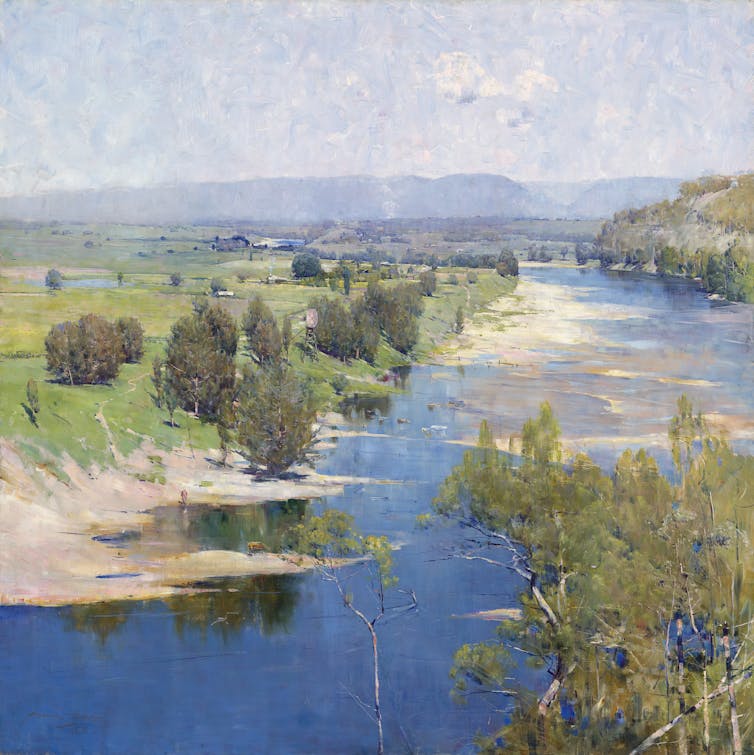 Arthur Streeton, Australia 1867–1943, The purple noon’s transparent might c.1896. Oil on canvas, 123.0 × 123.0 cm.
National Gallery of Victoria, Melbourne. Purchased1896
Arthur Streeton, Australia 1867–1943, The purple noon’s transparent might c.1896. Oil on canvas, 123.0 × 123.0 cm.
National Gallery of Victoria, Melbourne. Purchased1896
Many of the icons of Australian art, including Roberts’s Shearing the rams, Streeton’s Fire’s on, Roberts’s Break away and McCubbin’s The pioneer, share the space with William Barak’s images of the Rainbow serpent and sacred ceremonies.
I suspect this will become the definitive exhibition of our evergreen favourite national artists who created quintessential images of Australia that have ever since haunted our collective imagination.
She-Oak and sunlight: Australian Impressionism, is at NGV Australia until August 22.
Authors: Sasha Grishin, Adjunct Professor of Art History, Australian National University



